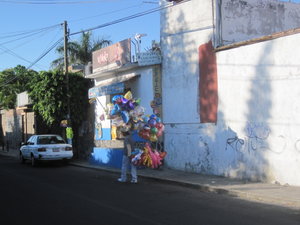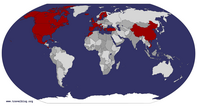Advertisement
Published: November 29th 2011

 Cuernavaca
Cuernavaca
The balloon sellerBack in the saddle again! Arriving in Mexico felt rather second nature in some respects, but then again, the difference from home abound! As we unpacked our suitcases in Cuernavaca, the birds squawked, the geckos.. I do not know what that sound would be called, the neighbor swept, the gas truck went by sounding its siren like an ice cream truck, someone called out what sounded like “mmles,” which turned out to be the tamale man. Then of course the smells coming from the kitchen were different as a spicy roasted chili smell greeted us. It felt great to be back, but where did I leave my Spanish?
Travelers from Italy, the United States, Australia, and who knows where else, have been encouraged to not visit Cuernavaca, I can guess due to the drug conflicts, though I there was no evidence of such that we saw. I wonder what has to happen in order for a government to prohibit travel to a place? The city felt the same to me- flowering trees, colorful houses, friendly greetings from passer-bys, parents really tending to their children, and so much more! The only clear change to me was that tourism is
certainly down, and everyone here is hurting from it. The language schools are closing or having to add other services beyond language instruction to their offerings in order to survive. It is frustrating to know that Mexico’s drug trafficking problem is caused by American drug consumption, and that people here are paying dearly for it.
This time of year in Mexico was new to both my mom and me. Our first week was spent dusting off our Spanish skills and getting into the preparations for the Dia de los Muertos! Visiting the market is always an overwhelming experience, as it is an assault on the senses! If you closed you eyes, you would know exactly where you were in the market- the meat section, the cheeses, the flowers, the produce, the spices, the herbs, the leather products, and so on. Of course, if you closed your eyes you would cause a real problem as the market is packed, and people know just where they are going to get what they need. Beyond the normal products, special Day of the Dead bread, flowers, candles, sweets, and decorations were for sale and people were there in mass to purchase
them!
We learned a lot about Day of the Dead as it is celebrated in this state, Morelos, of Mexico and I know the traditions vary around the country. Altars are prepared annually for the first three years after a loved one’s death, after this period, a visit to the cemetery and a less elaborate altar is often prepared in people’s homes. The first year, a family will have a substantial altar where they display a new set of clothes, which they lay out with a sugared skull as a head and then fill up with fresh fruits and vegetables. Around the “body” there will be flowers-marigolds and terciopelos, favorite foods or drinks of the deceased, photographs, many candles, and special bread. The following day, families head to the cemetery to clean, repaint, and adorn the graves of loved ones with flowers.
We had the amazing opportunity to visit a part of Cuernavaca called Ocotopec where the tradition is for families who have lost someone that year, to open their doors to the community. The experience was completely unique. We waited in long lines outside of houses where marigold petals and candles guided us,
and presumably the soul of the deceased, into the home. We then presented the family with a candle, which they will burn throughout the year and then spent time gazing at their incredible altars. Our teacher shared her observation that this year, the mood was more somber than they normally are due to the young age of the deceased. As visitors left the house, the family provided us with bread, coffee, juice, or other food and people then sat in plastic chairs outside the home enjoying their food and chatting away. Traditionally, the families provide mole or tamales for visitors, so our host family and teachers were surprised by the light fare offered, which they felt reflected the terrible economic situation. It was a rare opportunity to experience how this culture deals with death so differently from and I’ve ever known.
The following day we returned to Ocotopec to visit the cemetery. Seeing families camped out next to their loved one’s graves tending to it and just living life around it was astounding. Everything about the scene was such a far cry from any time I have ever spent in a cemetery. The colors of the monuments
were bright, the flowers were abundant, and people were eating cotton candy, which vendors were strolling around selling. The mood was festive, but not celebratory. A Mass was held in the center of the cemetery, which some families attended while others continued knitting, eating, and chatting with friends and family. Every now and again, the mariachi would start up a song that some family had requested be played for their loved one or a firework would boom out sending the souls back from where they came.
A day trip to Mexico City to see the Mexican Folk Ballet and the Basilica of Guadalupe had much more than we anticipated. The ballet, a 9:30am performance!, was very well done in that it showcased dances from various time periods and regions of Mexico and was in the beautiful Palacio de Bellas Artes. After much needed coffee and food, we then stumbled upon a competition of the Mexico City traditional art of alebrijes. The traditional alebrijes were made by one family in Mexico City out of papier-mâché and are a surreal combination of animals. Oaxaca artists have taken on another form of this, making small wooden animals that we saw
there last year. Anyway, the competition drew a huge crowd and was a treat to have come upon. We then took advantage of the streets being closed for bikes and pedestrians on Sundays, to walk over to see a Diego Rivera mural we had missed on previous visits, and we were, as always, greatly impressed by his skill and deeply aware of how much more we would need to know about Mexican history to really appreciate his works to the fullest. Our time at the Basilica was a huge disappointment. To reach the site, we had to weave our way through stalls filled with tacky goods like plastic Virgins. This seemed to go on for miles! Once in the actual complex, the magnitude of the place and the lack of information made our appreciation nearly impossible. The best part of that excursion was the public bus ride there, and the subway ride back, which were both great for people watching and feeling a part of such an enormous city!
As always, our teachers at school were incredible. For them to put up with the fact that I spend not one moment in between my visits to Mexico

 Las Catrinas
Las Catrinas
The tradition of the Catrinas began with an artist José Posada and was made famous by Diego Rivera. During Day of the Dead celebrations, elegant skeletons called Catrinas are everywhere!working on Spanish is really something! Though I think this year I may break the routine and try to keep up what I gained this year. Our Mexican friends proved incredibly generous, yet again, as they shared their time, food, homes, patience with our language skills, and so much more with us. Upon parting, one teacher gave me a lovely necklace, and the other a book of Mafalda cartoons. She shared that Mafalda is her heroine, and I think she may just be mine, too! Before leaving our host family, we picked up quite a few tips and tricks on how to make some of the dishes of theirs that we really enjoy. Beyond our improved language skills, we picked up some new culinary ones and a confidence in what we like in Mexican food that we did not have before!
After parting with Cuernavaca, we headed up to three towns north of Mexico City that had continued coming up in conversations over our years in Mexico. We set out by bus for Querétaro, about a five-hour drive. Traveling by bus in Mexico was nothing but positive for us this time, as all of our buses were
on time, clean, and comfortable. Querétaro was far larger than we had time to really see in our limited stay, but we did enjoy walking the narrow colonial streets, large shady gardens, and colonnaded plazas. There was a more cosmopolitan feel there than Cuernavaca. It is clear that books are valued in Querétaro as we passed numerous bookshops and book sales. The Saturday night crowds were great fun to mill around in and to appreciate the number of families spending time out together.
San Miguel de Allende was our next stop. We had heard about San Miguel from people over the years and knew it is full of American ex-pats and had wonderful charm. The town was indeed picturesque with lovely heavy wooden doors in brightly colored stuccoed homes and plenty of plazas to relax in. While wandering around the cobble stoned streets our first night, we followed the sound of live guitar music to a restaurant where we enjoyed an exceptional meal of veggies and shrimp cooked in a lava rock bowl with bubbling green chili salsa! Yum. Restaurant walls displayed boxes with skeletons doing all sorts of interesting things, which pop up all over Mexico,
but are originally from San Miguel.
Our third stop was to Guanajato, which I think took the prize of my personal favorite of the towns. The taxi from the bus to our hotel was by far the most interesting of such transfers we had! We passed through one long tunnel and then entered another where there was in intersection IN THE TUNNEL! It was bizarre! Then, as we neared the surface, we noticed stairs coming down to benches and people waiting for the bus! As you may have guessed, the town is built up on a mountain and the major industry here is mining. Again, the colonial style buildings, plazas, streets, theaters, and gardens were inviting. The Diego Rivera Museum was really interesting as it showed his early experimentations with art on his travels through Europe and therefore expanded my understanding of him and his art. I think what won me over though, was the university, which created gave the city a really great energy.
A new addition to our group in the form of my papa came for the last few days to Mexico City. After a long, and early, bus ride from
Guanajuato, we met him at the airport and swept him off to the main plaza and a nice meal. We were able to keep our upcoming trip to Cuba at bay and really enjoy a visit to Diego Rivera’s magnificent mural in the National Palace, peak into the ruins of Tenochtitlan, fight our way through traffic to Frida and Diego’s shared home, and then finally to Frida’s Casa Azul. Before long, it was time to pack up and strategize for our early morning departure to Cuba... more on that later.
Advertisement
Tot: 0.145s; Tpl: 0.014s; cc: 20; qc: 91; dbt: 0.0848s; 1; m:domysql w:travelblog (10.17.0.13); sld: 1;
; mem: 1.3mb























NORA
non-member comment
Felicitación
Jane y Katie, me da gusto saber que disfrutaron al máximo su estancia en Cuernavaca, ojala y regresen y podamos vernos..... muy buena la información y fotos. Les mando un fuerte abrazo